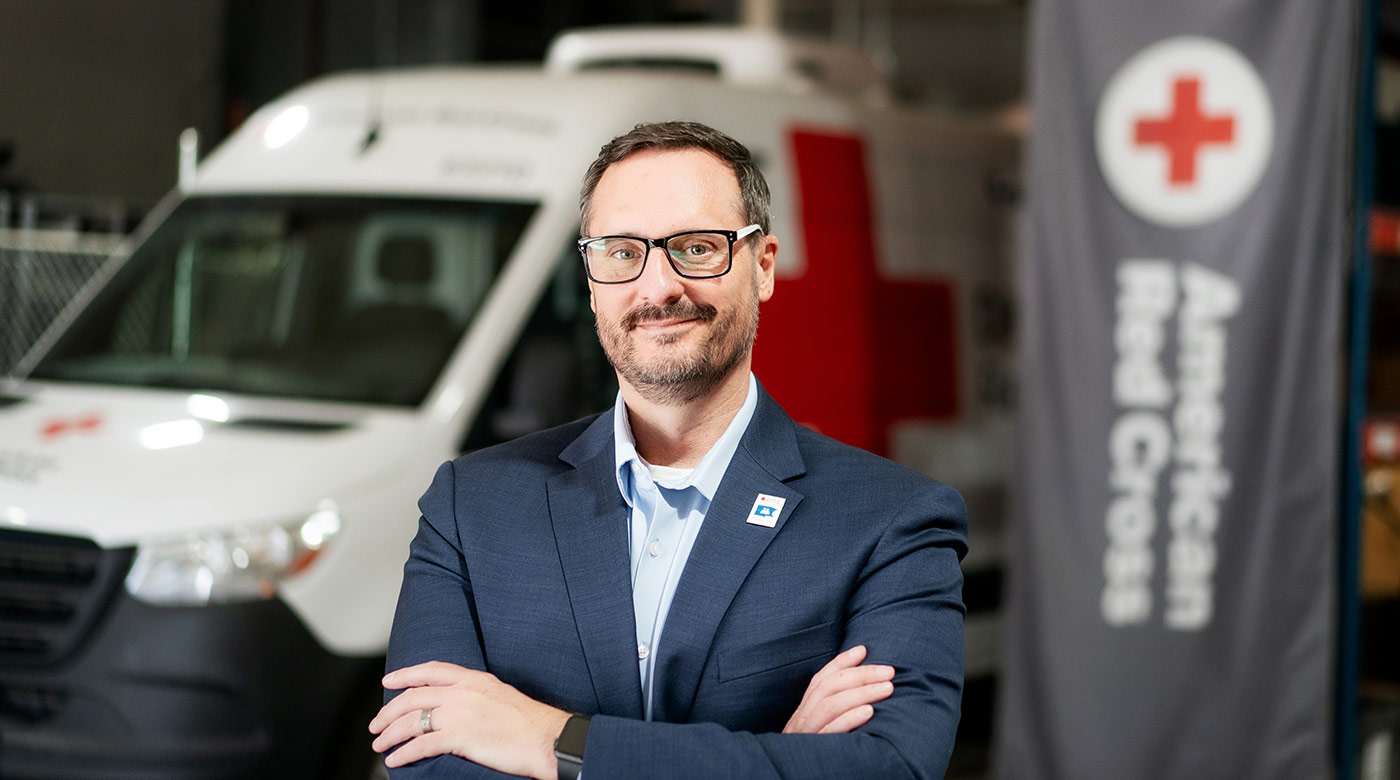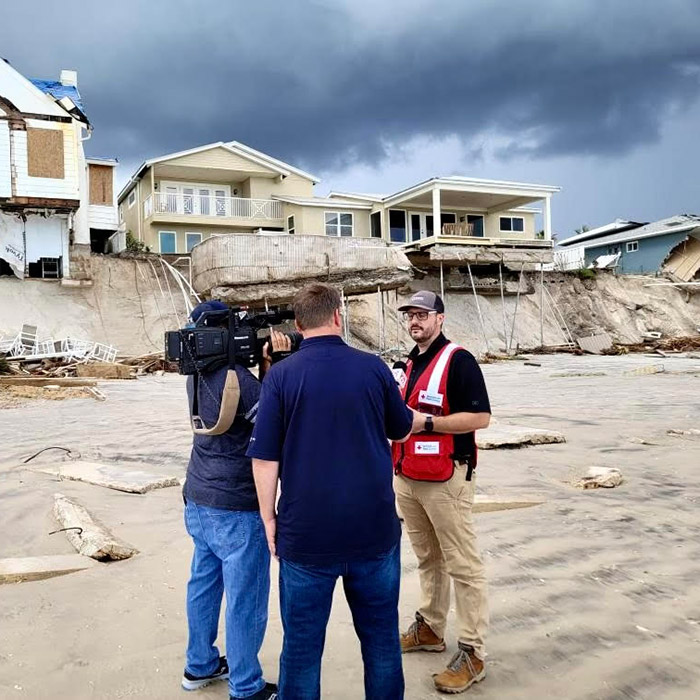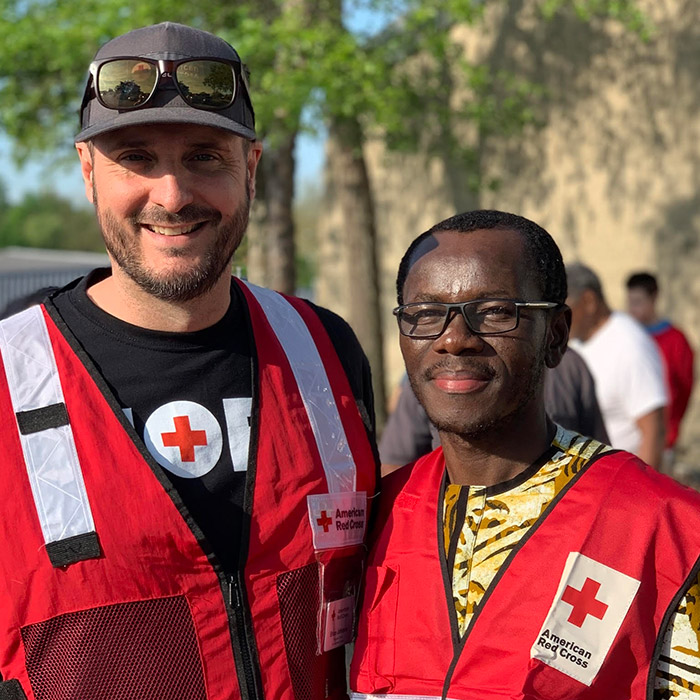Neighbors Helping Neighbors

Image: Brice Johnson ’99 (Photographed by Courtney Perry)
By Sarah Nystrom MFA '22
Resolute Writer
Brice Johnson ’99 finds vocation in Red Cross leadership.
Two neighborhoods in St. Paul, Minnesota share streets and a zip code. Interstate 94 runs down the middle, and since the freeway’s construction in the 1950s, the life expectancy between Summit Hill and the historically Black East Rondo neighborhood has widened, now differing by 20 to 25 years. It’s one of the largest life expectancy discrepancies in the nation, and it’s not something Brice Johnson ’99 can ignore.
“When you look at what side of the street determines how long you’re going to live, that’s really hard for me,” he says. “I can’t be okay with that.”
As the regional chief executive officer of the Minnesota and Dakotas Region of the American Red Cross — a chapter that serves 7.3 million people, including 23 sovereign tribal nations — Johnson is at once modest about his role, and also very aware of the organization’s international reputation for showing up in times of crisis.
At the height of the global refugee crisis in 2015, Johnson was working for YouthCompass International to engage youth at international schools in humanitarian service projects in Romania, Serbia and Croatia. As approximately 1.6 million refugees came to Germany, he watched as refugees got off the train and went straight to a Red Cross tent.
“And I just thought, what a powerful symbol. Nobody told them that they needed to go to that particular tent,” Johnson says. “They just migrated there because they knew it was a symbol of hope.”
Johnson tucked that image away in the back of his mind, not yet sure where it might direct him.
That’s just who Johnson is, says engineer and former classmate Tyler Kechely ’99: “Brice is always trying to find answers to the harder things in life, whatever the crisis might be. And the way he treats those around him makes you just want to root for him.”
Johnson and Kechely were not only housemates while at PLU, but also wrote and played music together in the folk-rock band Six Hours Later. Johnson wasn’t on the football team, yet both he and Kechely were influenced by the leadership of football coach Frosty Westering, whose book “Make the Big Time Where You Are” outlines his influential approach to team-building, motivation and value-setting.
Born and raised in Keizer, Oregon, Johnson was a communications major who loved professional basketball and whose dream job was to work in the NBA. Professors like Joanne Lisosky and Cliff Rowe helped Johnson make local connections in broadcast journalism and gain professional experience. Yet an internship with the Seattle Supersonics “pulled back the curtain on the industry,” and Johnson realized he wanted to have a more significant impact.
“One of the things that PLU does really well is that they instill in you that you have the ability to make an impact on the world,” he says.
The two years Johnson spent as assistant director of alumni and constituent relations at PLU were pivotal in his discernment process. Inspired by Mary Oliver’s 2008 visit, the campus conversation at the time circled around the final line of “A Summer Day” her 1992 poem: “Tell me, what is it you plan to do / with your one wild and precious life?”


The question stuck with Johnson during his time in Europe, and when a volunteer recruiter role opened up at the Indiana Red Cross, despite being “slightly overqualified,” he jumped at the opportunity. Yet the transition wasn’t without its difficulties: right before Johnson and his family moved back to the U.S., the first case of COVID-19 was found in Germany, in a small town where Johnson had just coached a basketball game.
Johnson’s first years at the Red Cross were challenging, as the organization made the switch to remote work while also serving at the forefront of an international public health emergency. Johnson drew on his years of experience serving in environments where he often had to adapt, environments where he might start his day in a suit and tie to appear on the morning news and then change to basketball shorts and a tee-shirt for an afternoon event in the community. During the pandemic, flexibility and a deep sense of camaraderie defined Red Cross staff and volunteers, as well as the commitment to help the communities they were serving.
Last year, the American Red Cross responded to 28 billion-dollar disasters; in the 1980s, three or four would have been typical. Even when disasters occur far beyond his region, as with last year’s devastating wildfires in Maui, Johnson and his team send volunteers, raise money, encourage blood donations, and recruit volunteers.
Now, Johnson and his team focus on building community capacity while continuing to meet basic human needs. Sometimes that’s quietly working behind the scenes with families in the aftermath of a mass shooting; sometimes it’s working with a family after a home fire or a hurricane; sometimes it’s buying a refrigerator to support a food pantry in the South.
The need is increasing, but whatever the crisis, the American Red Cross remains rooted in the 19th century mission born on the battlefields of the U.S. and Europe: to help people who are hurting.
Sometimes that requires a bit of creativity. Julie Nelson, regional chief operating officer of the Minnesota-Dakotas region, recalls responding to a heavy snowstorm on the Pine Ridge Reservation in South Dakota last winter. The tribal community had its own shelter and sufficient supplies but didn’t have a backup generator. Even though, as Johnson says, the Red Cross typically isn’t in the business of buying generators, his team worked with the Margaret A. Cargill Foundation to purchase and install a generator, increasing the tribal community’s self-reliance.
Nelson says none of this could have happened without taking the time to build trusting relationships and engage the community as an active partner. Seemingly small acts of support such as buying a fridge or a generator mark a move from community engagement that’s transactional to community engagement that’s transformational.
Still, responding to so many traumatic incidents takes its toll, especially on volunteers deploying multiple times a year. Ninety percent of the organization’s workforce are volunteers, and that includes volunteers working in disaster mental health. Their expertise, along with an organizational commitment to lift each other up, enables the staff and volunteers of the Red Cross to continue to respond with compassion, often to people who were strangers only moments before.
Johnson remembers a moment after a tornado in Sullivan, Indiana, when a Red Cross executive director stepped toward a woman looking at her destroyed home, and said, “You look like you need a hug.”
Nelson finds a similar strength in Johnson: “He has a knack for creating psychological safety by being an authentic and thoughtful leader who actively listens and validates concerns.”
For Johnson, holding space for others is just part of his primary goal.
“I want to get to a point where neighbors are helping neighbors,” he says. “And whether or not it has the Red Cross name on it doesn’t really matter to me. I want them to be equipped to help each other.”


